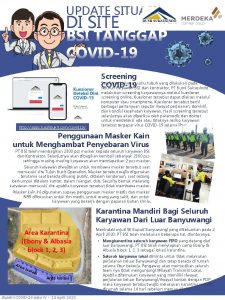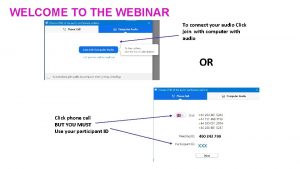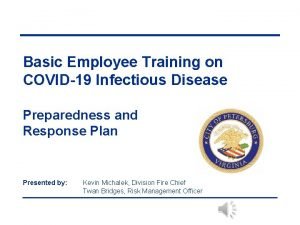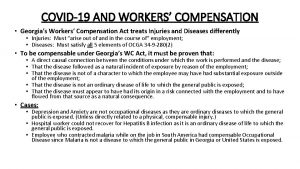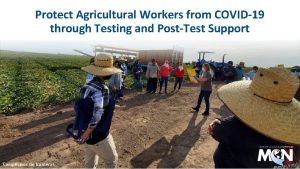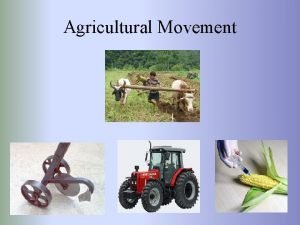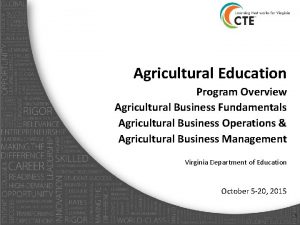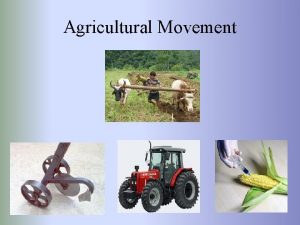COVID19 MiniQuiz Advice for Agricultural workers and Industrial









- Slides: 9

COVID-19 Mini-Quiz Advice for Agricultural workers and Industrial Fishers and Tips for Recruiting during the Pandemic

What is Covid-19? COVID-19 is a respiratory disease caused by SARS-Co. V-2, a new coronavirus discovered in 2019. The virus is thought to spread mainly from person to person through respiratory droplets produced when an infected person coughs, sneezes, or talks. ● Some people who are infected may not have symptoms ● Symptoms may appear 2 -14 days after someone is exposed to the virus and can include fever, chills, and cough. ● For people who have symptoms, illness can range from mild to severe ● Adults 65 years and older and people of any age with underlying medical conditions are at higher risk for severe illness ● At this time, there is no vaccine to prevent infection Source: https: //www. cdc. gov/dotw/covid 19/index. html#: ~: text=COVID%2 D 19%20 is%20 a%20 respiratory, coughs%2 C%20 sneezes%2 C %20 or%20 talks.

Dangers of Covid-19 for Farmworkers COVID-19 has been especially devastating for rural communities and for agricultural workers across the country. ● 99% of rural counties in the United States have reported positive cases of COVID-19 and 81% of rural counties have reported one or more COVID 19 related deaths. ● The case rate of COVID-19 (cases per 10, 000 people) in rural counties has increased by 392% since July 2020. ● There have been COVID-19 outbreaks in over 700 meat packing plants across the country ● The CDC has tracked COVID-19 outbreaks amongst farmworkers in 18 different states ● Purdue University estimates that more than 145, 000 agricultural workers have tested positive for COVID-19 nationwide, but this figure likely underestimates the number greatly since it excludes contracted and temporary labor. Source: http: //www. ncfh. org/msaws-and-covid-19. html

Dangers of Covid-19 for Farmworkers There are numerous factors that put farmworkers at an increased risk of contracting COVID-19. They include: ● Distance Between Workers– Farmworkers often have close contact to one another both in the fields and indoors. Workers may also be near one another at other times, such as when clocking in or out, during breaks, when sharing transportation, or in shared housing. ● Duration of Contact– Farmworkers often have prolonged close contact with coworkers, both on the work site and during transportation and in some housing. Continued contact with potentially infectious individuals increases the risk of COVID-19 transmission. ● Lack of Access to Water- Farmworkers at home and at work often lack access to clean water for hygiene purposes. Source: https: //www. cdc. gov/coronavirus/2019 -ncov/community/guidance-agriculturalworkers. html

CDC COVID-19 Recommendations for Farmworkers The CDC recommends the following steps to help farm owners and farmworkers protect themselves from the spread of COVID-19: ● Take regular temperature of anyone entering worksite to identify anyone with temperature above 100. 4 ℉ ● Use proper PPE (gloves, face, and eye protection) while working and frequently use an alcohol based hand sanitizer that contains at least 60% alcohol ● Routinely clean and sanitize common areas and shared living spaces according to CDC cleaning and disinfection guidelines ● Adjust workflow to allow for 6 foot distance between workers ● Add additional clock in/out stations to reduce crowding ● Arrange break/common area on site to allow for social distancing when not working Source: http: //www. ncfh. org/msaws-and-covid-19. html

COVID-19 Resources for Farmworkers Farmworker Justice has a great list of resources available to farmworkers discussing COVID-19. Resources include: ● Link to the CDC official guidelines for farmworkers ● Links to videos in Spanish discussing the dangers of COVID-19 and ways farmworkers can protect themselves ● Links to videos in seven Mayan dialects discussing COVID-19 ● Links to resources available to farmworkers in 20 different states https: //www. farmworkerjustice. org/advocacy_program/covid-19/

ID&R during the COVID-19 Pandemic During the COVID-19 pandemic the national Office of Migrant of Education (OME) has authorized states to carry out the identification and recruitment of students remotely ● OME recommends all states follow their own State Educational Agency local school district guidelines for conducting ID&R tasks during the COVID-19 pandemic ● OME has authorized for MEP programs to proceed with eligibility determinations for new students on COEs without interviewee signature as long as all other necessary information has been collected ● ID&R eligibility interviews can be conducted via telephone, facetime, whatsapp phone calls or video calls, zoom, or any other internet calling service Source: https: //results-assets. s 3. amazonaws. com/legislation/COVID-19_MEP_Fact_Sheet. pdf

ID&R during the COVID-19 Pandemic Recruiting remotely over the phone or via video call can be different than recruiting in the field. Here are some tips to help make recruiting over the phone easier: ● Always use a work phone number when calling potential students or their families ● Before making calls, try to connect with potential students or their families first via whatsapp, Facebook, or another messaging service to coordinate a time to conduct the interview ● Take a picture of an official identification or business card to send via text or whatsapp to help build confidence with potential students or their families ● Have ready a list of available COVID-19 resources and available assistance in your recruiting area ● Always ask potential students or their families how they are doing and if they have any needs related to COVID-19

ID&R during the COVID-19 Pandemic If it is necessary to go into the field to recruit or to drop off materials be sure to follow your state guidelines for protecting yourself from COVID-19. Here are some tips for staying safe out in the field: ● All ID&R staff should wear proper PPE (mask and gloves) equipment at all times and wash hands frequently. Carry 60% alcohol hand sanitizer at all times and use it after each visit. ● Carry extra PPE to ensure all interviewees have masks to wear ● Recruiters should not enter living quarters or farmworker housing. All recruiting activities can be conducted outside or from the front porch. ● Recruiters should maintain 8 feet between them and who they are speaking with. You can use your car to help maintain distance. ● Do not speak to anyone for longer than 15 minutes ● When dropping off materials, leave materials by the front door and alert the student or their family when you have returned to your car
